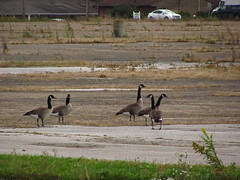 Aurora, Ohio – Friday, October 14th, 2011
Aurora, Ohio – Friday, October 14th, 2011
The overcast skies part for a moment, allowing the October sun to cast a long, crisp shadow in front of me. Nearby a flock of Canadian Geese are taking a respite from their southerly flight, and all that can be heard apart from the muted Doppler effect from distant traffic is the rattling of dried leafs scuttled by wind across the pavement like fiddler crabs. I take out my cell phone and dial the most recent contact.
“Hello?”
“Listen, I got caught by security for trespassing.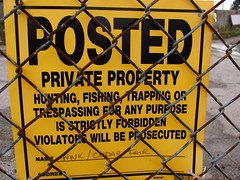 They’re driving me down to the police station right now. I need you to come downtown to post bail.”
They’re driving me down to the police station right now. I need you to come downtown to post bail.”
“Oh my god! You’re kidding?”
“You’re right, I am kidding. This place is dead. Anyway, I think there’s an access road along the back of the property if you drive down Aurora Road a little bit further. You’ll see it on the right. I’ll meet you along there in ten minutes.”
Obviously I wasn’t stupid enough to attempt to scale any fences marked “Private Property”. Although the land for the parking lot and other areas around the perimeter fence are also owned by Cedar Fair, without any barriers or signs protecting this land from the outside world I appeared to be perfectly within my legal ability to walk right up to the front gate and take as many pictures as I pleased. Or, at least, within my personal physical ability to do so without getting caught. Graffiti and broken beer and whiskey bottles strewn next to the admission ticket booths suggested I was not the first to pay the shuttered amusement park a visit, nor if I was willing to wait long enough would I be the last.
owned by Cedar Fair, without any barriers or signs protecting this land from the outside world I appeared to be perfectly within my legal ability to walk right up to the front gate and take as many pictures as I pleased. Or, at least, within my personal physical ability to do so without getting caught. Graffiti and broken beer and whiskey bottles strewn next to the admission ticket booths suggested I was not the first to pay the shuttered amusement park a visit, nor if I was willing to wait long enough would I be the last.
It’s amazing how quickly nature can reclaim land. Weeds taller than waist-height are already peeking through every concrete gap that can be found, the paint uniformly weathered and faded, and the entire parking lot looks like it recently survived an earthquake. It was less than four years ago when Geauga Lake finished what seemed like the end of just another season, only to post a brief and largely unexpected announcement the next week that they would be taking the 119 year old amusement park in a “new and exciting” direction by focusing their attention exclusively on the 20 acre “premier water park in northeast Ohio” they opened four years ago over the demolished remains of the formerly 56 acre SeaWorld Ohio. Apparently according to guest feedback surveys this water park had made redundant any need for the historic amusement park on the opposite side of the lake, so although they were sad to see the roller coasters go, this was a long-term win for everyone, especially for Cedar Fair.
It was less than four years ago when Geauga Lake finished what seemed like the end of just another season, only to post a brief and largely unexpected announcement the next week that they would be taking the 119 year old amusement park in a “new and exciting” direction by focusing their attention exclusively on the 20 acre “premier water park in northeast Ohio” they opened four years ago over the demolished remains of the formerly 56 acre SeaWorld Ohio. Apparently according to guest feedback surveys this water park had made redundant any need for the historic amusement park on the opposite side of the lake, so although they were sad to see the roller coasters go, this was a long-term win for everyone, especially for Cedar Fair.
 I can’t decide. Whoever was tasked with drafting that letter either held a profound cynicism and condescension towards the many stakeholders in the community to believe that spinning the permanent closure
I can’t decide. Whoever was tasked with drafting that letter either held a profound cynicism and condescension towards the many stakeholders in the community to believe that spinning the permanent closure and demolition of Geauga Lake as a good thing would help maintain their positive image, or it was just another example of Cedar Fair’s general incompetence at anything that requires an understanding of more emotional depth than “build big colorful roller coaster, throw confetti, and cash check at bank”. (It was signed by the park’s General Manager Bill Spehn, but carried the distinct reek of being wrung through their
and demolition of Geauga Lake as a good thing would help maintain their positive image, or it was just another example of Cedar Fair’s general incompetence at anything that requires an understanding of more emotional depth than “build big colorful roller coaster, throw confetti, and cash check at bank”. (It was signed by the park’s General Manager Bill Spehn, but carried the distinct reek of being wrung through their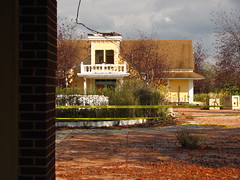 PR Department’s spin machine several times.) Listen, PR professionals across the world, there are times when the best way to preserve a favorable image with people is to admit some culpability and shared remorse for an unpleasant but necessary situation. Later press releases and interviews at least showed the company had the common decency to demonstrate some humility and regret over the decision. Cedar Fair CEO Dick Kinzel lamented that it was his decision to buy the property off of Six Flags in March of 2004, and the surprising financial failure of the park after only five years of removing rides and aggressive depersonalization of the park turning it into “Cedar Point East” ultimately reflected as his failure as a business person.
PR Department’s spin machine several times.) Listen, PR professionals across the world, there are times when the best way to preserve a favorable image with people is to admit some culpability and shared remorse for an unpleasant but necessary situation. Later press releases and interviews at least showed the company had the common decency to demonstrate some humility and regret over the decision. Cedar Fair CEO Dick Kinzel lamented that it was his decision to buy the property off of Six Flags in March of 2004, and the surprising financial failure of the park after only five years of removing rides and aggressive depersonalization of the park turning it into “Cedar Point East” ultimately reflected as his failure as a business person.
The closure was partly justified by rising real estate values that made the lakeside location more valuable for other commercial purposes. It was a vague promise that even though it was sad to see it removed, something of value would soon take its place, probably in the form of a strip mall or upscale residential complex that would be a boon for the local economy. One year later the economy would crash and Geauga Lake would seem destined to remain a rotting hole in the ground southeast of Cleveland for the better part of the next decade.
Some rides would be relocated to other parks in the chain while most others would either be auctioned off or sold for scrap. The property has been stripped of all steel structures save for the old Geronimo SkyCoaster, which I’m guessing the tall spindly structure must have required a specialized deconstruction process too expensive to offset the going rate for scrap steel. That was my first (and, even to this day, only) sky coaster I’ve ever been on, way back in 2001. I don’t remember much except for I had a bit of difficulty pulling the cord on the first try. I must not have found the experience that followed to be memorable enough to be worth paying the upcharge again. However, the first time I went to Geauga Lake was two seasons prior in 1999, before the park turned into Six Flags Ohio which was before the park turned into Six Flags Worlds of Adventure which was before it turned back into Geauga Lake (whew).
The property has been stripped of all steel structures save for the old Geronimo SkyCoaster, which I’m guessing the tall spindly structure must have required a specialized deconstruction process too expensive to offset the going rate for scrap steel. That was my first (and, even to this day, only) sky coaster I’ve ever been on, way back in 2001. I don’t remember much except for I had a bit of difficulty pulling the cord on the first try. I must not have found the experience that followed to be memorable enough to be worth paying the upcharge again. However, the first time I went to Geauga Lake was two seasons prior in 1999, before the park turned into Six Flags Ohio which was before the park turned into Six Flags Worlds of Adventure which was before it turned back into Geauga Lake (whew).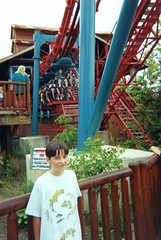 The Serial Thriller was the big, impressive
The Serial Thriller was the big, impressive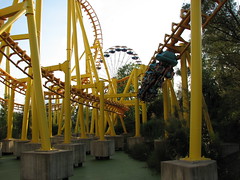 new roller coaster, although it wouldn’t last that way for long. I loved it back then, almost as much as Raptor. It has since been relocated to my home park and renamed Thunderhawk. It’s still one of the smoother SLCs I’ve ever ridden, but I wish I could retain anywhere near the same affection for it that I had back then. That evening when the line went down my dad and I ran around and rode it as many times as we could,
new roller coaster, although it wouldn’t last that way for long. I loved it back then, almost as much as Raptor. It has since been relocated to my home park and renamed Thunderhawk. It’s still one of the smoother SLCs I’ve ever ridden, but I wish I could retain anywhere near the same affection for it that I had back then. That evening when the line went down my dad and I ran around and rode it as many times as we could,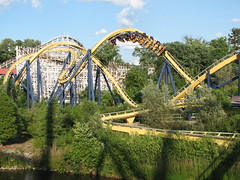 one of the first times I got to marathon a “major” looping steel coaster.
one of the first times I got to marathon a “major” looping steel coaster.
We did the same with the Dominator on our very last visit in 2007. It was August and had we known that in less than two months the park would close forever we would have taken a lot more pictures and bought a lot more souvenirs. I still consider that ride (formerly Batman: Knight Flight) one of B&M’s best above-the-rails looping coasters ever made, along with Busch Garden’s Kumba. Although it only has five inversions, it also has the longest layout of any floorless coaster which means there’s more track devoted to a unique, non-standard layout. The massive, hangtime-filled vertical loop opener that leads directly into a lightning fast overbanked speed curve a few meters above the entrance was about as good as B&M ever got (at least with their floorless designs), and this particular cobra roll always felt more special to me. Probably because it was incredibly iconic set right above the entrance,
fast overbanked speed curve a few meters above the entrance was about as good as B&M ever got (at least with their floorless designs), and this particular cobra roll always felt more special to me. Probably because it was incredibly iconic set right above the entrance,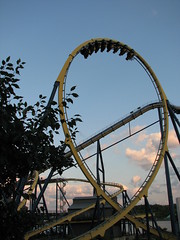 and because it wasn’t immediately bordered on either side with another inversion. If I recall correctly, they also had Pink Floyd’s Welcome to the Machine playing over the station safety announcements. That was one of the few examples of Cedar Fair demonstrating halfway good taste. Dominator has since been relocated to King’s Dominion under the same name (how apropos), although it’s missing the cobra roll/overbanked turn walk-under at the main entrance. Sadly, the unique location at the edge of the lake set over a marshy, island-filled cove has also been substituted with a location at the edge of a parking lot set over an empty grass field, but at least the paint job looks better. I don’t know yet if the soundtrack has
and because it wasn’t immediately bordered on either side with another inversion. If I recall correctly, they also had Pink Floyd’s Welcome to the Machine playing over the station safety announcements. That was one of the few examples of Cedar Fair demonstrating halfway good taste. Dominator has since been relocated to King’s Dominion under the same name (how apropos), although it’s missing the cobra roll/overbanked turn walk-under at the main entrance. Sadly, the unique location at the edge of the lake set over a marshy, island-filled cove has also been substituted with a location at the edge of a parking lot set over an empty grass field, but at least the paint job looks better. I don’t know yet if the soundtrack has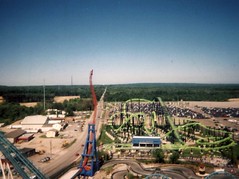 also moved to Virginia or not.
also moved to Virginia or not.
Although the Dominator was as good as ever in 2007, the 1950’s Americana themed section (creatively called “50’s Midway” on the guides) on the southern side of the park was an ominous warning of what was soon to come that I should have taken more serious heed of. Steel Venom (formerly Superman Ultimate Escape) and X-Flight had both already been removed the previous winter, leaving behind nothing but some footers and the shell of a station platform. Both the Skyscraper observation tower and Bellaire Express monorail were decommissioned, although that was no recent news for either. Perhaps the biggest loss was Mr. Hyde’s Nasty Fall, a rare Intamin First Generation drop tower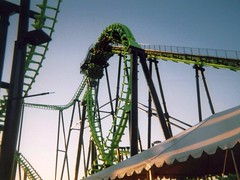 with a clever 1950’s B-horror movie drive-in theme. Removed in 2005, there was little more than a façade covering a hole in the ground in 2007. Likewise, the nearby waterpark had been abandoned and left to rot with the opening of Wildwater Kingdom across the lake.
with a clever 1950’s B-horror movie drive-in theme. Removed in 2005, there was little more than a façade covering a hole in the ground in 2007. Likewise, the nearby waterpark had been abandoned and left to rot with the opening of Wildwater Kingdom across the lake.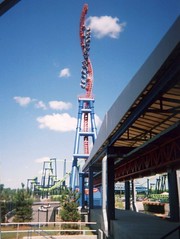
Apart from the Big Dipper, this left only the Head Spin Vekoma Boomerang and the also uniquely themed El Dorado as the last significant rides in the area. Needless to say, it was a bit depressing to walk through. At the time I naïvely believed that the area would have to be getting a major renovation in the near future, maybe not to bring back any major rides (Steel Venom and X-Flight, both parts of enormous but sloppy Six Flags expansions to headline their back-to-back rebranding efforts in 2000 and 2001, never felt like they belonged at Geauga Lake anyway so I didn’t mourn their departures for Cincinnati and Allentown) but at least they would add some new flat rides or other decorations that would bring back an updated look to the area’s faded pastels and broken neon.
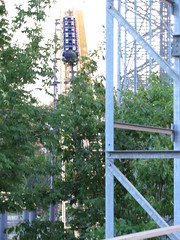 The former Coyote Creek section was probably the best area of the park. Although not on the lakefront, the older, classic rides fit well with the rustic architecture and mature trees covering the smaller winding pathways that escaped the bustle and agoraphobia of the main midways. The 1972-built Log Flume (operating under various bottled beverage sponsored names during its later years, although known as the Gold Rush for most of its life prior to Premier Parks’ takeover) was one of the extreme few wooden structured flume rides remaining at an American amusement park. A Mack Matterhorn flat ride called the Hay Baler felt very much at home inside a rustic barn. And the 1977 Arrow Dynamics-built Double Loop, despite being undersized and outclassed by the other modern steel coasters, I always found to be a funky and retro flavor of fun. A wooden tunnel right out of the station recalled several classic wooden coaster designs, and the first hill and turnaround that narrowly scraped through a canopy of trees was delightful without having to try very hard. Then it got to the ride’s namesake, a pair of partially subterranean vertical loops followed by a rapid downhill helix that could make me dizzy in a way that the big Beemer across the midway could not.
The former Coyote Creek section was probably the best area of the park. Although not on the lakefront, the older, classic rides fit well with the rustic architecture and mature trees covering the smaller winding pathways that escaped the bustle and agoraphobia of the main midways. The 1972-built Log Flume (operating under various bottled beverage sponsored names during its later years, although known as the Gold Rush for most of its life prior to Premier Parks’ takeover) was one of the extreme few wooden structured flume rides remaining at an American amusement park. A Mack Matterhorn flat ride called the Hay Baler felt very much at home inside a rustic barn. And the 1977 Arrow Dynamics-built Double Loop, despite being undersized and outclassed by the other modern steel coasters, I always found to be a funky and retro flavor of fun. A wooden tunnel right out of the station recalled several classic wooden coaster designs, and the first hill and turnaround that narrowly scraped through a canopy of trees was delightful without having to try very hard. Then it got to the ride’s namesake, a pair of partially subterranean vertical loops followed by a rapid downhill helix that could make me dizzy in a way that the big Beemer across the midway could not.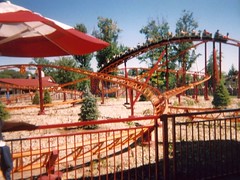
The reason this area was relatively pleasant even up to the very last years probably has to do with the fact that Six Flags hardly touched it except for the addition of the Villain. That was the only major attraction built under Six Flag’s watch that felt ‘right’ at Geauga Lake, something that Funtime might have built that year had they never sold out to Premier Parks five years earlier. Aside from the thematic continuity with the area, the ride itself was a natural fit along the far perimeter of the park, its old west entrance and station placed alongside the Double Loop’s for a nice one-two combo of traditional roller coaster experiences. The Villain was a deceptively large ride; at 120 feet it was about the same scale as Shivering Timbers, with some equally towering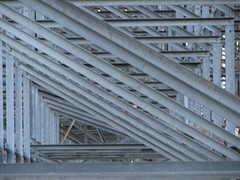 camelback hills. Unfortunately it was built by Custom Coasters International in the year 2000, which meant its rolling stock would be provided by Gerstlauer. The Villain picked up some notoriety for roughness and was generally not aided by poor operations which meant a rough ride was only found at the end of a long, slow queue (with one train operation I only got two final rides in 2007 despite the rest of the park being nearly empty; the second lap demonstrated considerable dedication towards the hobby on my part). However, I always found claims by local fans that if it could be maintained and operated properly then it would reveal itself to be a top ten wooden coaster to be a little shallow. Sure, it was a big wooden coaster with a few killer drops near the start, but even on its best days a double out-and-back tracing a broad circle with no progression
camelback hills. Unfortunately it was built by Custom Coasters International in the year 2000, which meant its rolling stock would be provided by Gerstlauer. The Villain picked up some notoriety for roughness and was generally not aided by poor operations which meant a rough ride was only found at the end of a long, slow queue (with one train operation I only got two final rides in 2007 despite the rest of the park being nearly empty; the second lap demonstrated considerable dedication towards the hobby on my part). However, I always found claims by local fans that if it could be maintained and operated properly then it would reveal itself to be a top ten wooden coaster to be a little shallow. Sure, it was a big wooden coaster with a few killer drops near the start, but even on its best days a double out-and-back tracing a broad circle with no progression and little variation would have a very hard time amounting to anything deserving worldwide recognition. Not that I ever wished it to end in a scrap heap after a mere eight years of service life.
and little variation would have a very hard time amounting to anything deserving worldwide recognition. Not that I ever wished it to end in a scrap heap after a mere eight years of service life.
Today, the Villain and Double Loop refer to nothing more than an abandoned lot of weeds and rubble, their steel structures too unwieldy to relocate intact but too valuable to simply abandon. Only the wooden farmhouse for the Hay Baler and a couple other small buildings are still standing in Coyote Creek. The Raging Wolf Bobs has had much of its track chopped and piled up, but the superstructure still remains in the far back corner of the park. That ride wasn’t much of a loss; it barely ever operated in its last years, and when it did it had a nasty tendency to derail. My memories are vague, as I only remember even seeing it run back in 1999 and 2001, when I recall a very rough, slow, and dynamically uninteresting ride, assuredly the opposite of what its Chicago namesake was said to be like. Maybe I would have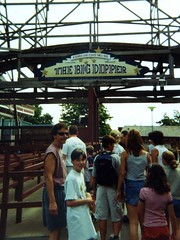 enjoyed the Bobs earlier in its life, but otherwise it seems like a perfect example of why remakes are a bad idea even in amusement parks.
enjoyed the Bobs earlier in its life, but otherwise it seems like a perfect example of why remakes are a bad idea even in amusement parks.
That leaves the Big Dipper as the only completely intact roller coaster structure still standing on the property. It opened in 1925. It was older at the time the next oldest major attractions first opened (Log Flume and Double Loop) than either of those attractions were when they were ripped out in 2007. Yet the Big Dipper continues to live on, but just barely. Not much of an effort was made to save it. Cedar Fair offered ACE and the National Roller Coaster Museum the first chance to bid on it, but when the price wasn’t right (neither organization is financially secure these days, and a relocation requires at least seven figures even if the material is offered for free) rather than work out a deal with another park or professional team in the industry which would guarantee the historic ride’s continued existence, they opted for the quick profit and unexpectedly placed it on the general auction where it went to Apex Western Machine Movers, a company with no experience, land, or even an intention with personally relocating a roller coaster, for the bargain price of $5,000. When ACE tried to negotiate another deal to save the coaster, Apex agreed on the condition that their inexperienced company would be hired to do the deconstruction at a going rate in the hundreds of thousands of dollars. ACE was forced to decline. By this point Cedar Fair could be of no
and a relocation requires at least seven figures even if the material is offered for free) rather than work out a deal with another park or professional team in the industry which would guarantee the historic ride’s continued existence, they opted for the quick profit and unexpectedly placed it on the general auction where it went to Apex Western Machine Movers, a company with no experience, land, or even an intention with personally relocating a roller coaster, for the bargain price of $5,000. When ACE tried to negotiate another deal to save the coaster, Apex agreed on the condition that their inexperienced company would be hired to do the deconstruction at a going rate in the hundreds of thousands of dollars. ACE was forced to decline. By this point Cedar Fair could be of no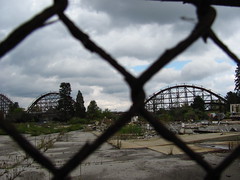 further assistance. The ride was sold, and their office in Sandusky had cleaned their hands of the Big Dipper. They bore no responsibility for its fate.
further assistance. The ride was sold, and their office in Sandusky had cleaned their hands of the Big Dipper. They bore no responsibility for its fate.
But of course nobody regretted the decision to close the amusement park and relocate, auction, or demolish the rides more than Cedar Fair did. After all, the park had only been the economic backbone of the community for 120 years, and it’s never an easy decision when the parent company that acquired the property five years prior has to liquidate some assets to help ease the debt burden of an even bigger acquisition made in 2006.1 They lost a lot of money on this deal. It’s not like the community, long-time patrons, or other stakeholders had lost anything nearly as significant. The city and citizens of Aurora never once used community resources to support the economic well-being and growth of Geauga Lake at any time during the past century, so why should they feel annoyed that everything of value on that property was shipped off or chopped down by a company that had no involvement in the community five years prior? They have no business with Cedar Fair’s affairs, so how could anyone blame them for less than ethical behavior when they kept the impending closure a secret from everybody (even instructing employees to lie about their future demolition plans when directly asked by suspicious patrons) until long after the writ of execution had already been signed and delivered?
to support the economic well-being and growth of Geauga Lake at any time during the past century, so why should they feel annoyed that everything of value on that property was shipped off or chopped down by a company that had no involvement in the community five years prior? They have no business with Cedar Fair’s affairs, so how could anyone blame them for less than ethical behavior when they kept the impending closure a secret from everybody (even instructing employees to lie about their future demolition plans when directly asked by suspicious patrons) until long after the writ of execution had already been signed and delivered?
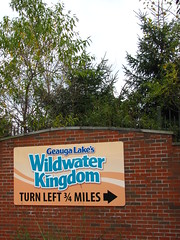 Still, I have to admit that ever since the Geauga Lake closure and Paramount Parks acquisition, the company culture at Cedar Fair has seemed… different. I used to idolize them. During an era when Six Flags seemed bent on buying every single small park across the country and filling them with context insensitive DC Comics themed roller coasters and jacking up parking and food prices while lowering the rates of season passes, Cedar Fair seemed like the good guys by comparison. They knew how to keep their parks fun, clean, a good value for the money, and could build a good roller coaster every now and again. The best part was, they resisted a trend of bland corporatization seen at other park chains and allowed their properties a relatively large degree of self-determination at the local level. When it was announced my home park, Michigan’s Adventure, would now be covered by the same season pass as we used at Cedar Point, I thought it was a dream come true.
Still, I have to admit that ever since the Geauga Lake closure and Paramount Parks acquisition, the company culture at Cedar Fair has seemed… different. I used to idolize them. During an era when Six Flags seemed bent on buying every single small park across the country and filling them with context insensitive DC Comics themed roller coasters and jacking up parking and food prices while lowering the rates of season passes, Cedar Fair seemed like the good guys by comparison. They knew how to keep their parks fun, clean, a good value for the money, and could build a good roller coaster every now and again. The best part was, they resisted a trend of bland corporatization seen at other park chains and allowed their properties a relatively large degree of self-determination at the local level. When it was announced my home park, Michigan’s Adventure, would now be covered by the same season pass as we used at Cedar Point, I thought it was a dream come true.
As Six Flags Ohio and then Six Flags Worlds of Adventure (a name that promised much more than it could actually deliver) I was pleased with the new coasters but thought they didn’t necessarily belong at this park. Six Flags acknowledged pretty directly (even in their advertising) they wanted to go head-to-head with Cedar Point, which was a bad fight to pick. Not necessarily because Six Flags couldn’t do better than Cedar Point, but because Northern Ohio isn’t exactly a place of economic prosperity with tons of disposable leisure dollars among the population. Did they really think it could handle two high-priced mega parks? Geauga Lake’s fate was probably sealed as soon as Funtime sold to Premier and the competitive nature of the industry (coupled with the fact that the amusement industry tends to be run by businesspeople who couldn’t make it in more profitable but cutthroat sectors; no offense…) forced the park to grow faster than the market could possibly bear. To be honest, I was glad when Cedar Fair started taking down the major coasters Six Flags put in and relocating them to different parks in the chain that needed the growth. Cleveland deserved to have a smaller, mid-priced regional family park, and I was willing to overlook the fact that in the wake of these ride removals many parts of Geauga Lake were starting to resemble certain parts of Cleveland you wouldn’t want to walk through alone at night.
with the new coasters but thought they didn’t necessarily belong at this park. Six Flags acknowledged pretty directly (even in their advertising) they wanted to go head-to-head with Cedar Point, which was a bad fight to pick. Not necessarily because Six Flags couldn’t do better than Cedar Point, but because Northern Ohio isn’t exactly a place of economic prosperity with tons of disposable leisure dollars among the population. Did they really think it could handle two high-priced mega parks? Geauga Lake’s fate was probably sealed as soon as Funtime sold to Premier and the competitive nature of the industry (coupled with the fact that the amusement industry tends to be run by businesspeople who couldn’t make it in more profitable but cutthroat sectors; no offense…) forced the park to grow faster than the market could possibly bear. To be honest, I was glad when Cedar Fair started taking down the major coasters Six Flags put in and relocating them to different parks in the chain that needed the growth. Cleveland deserved to have a smaller, mid-priced regional family park, and I was willing to overlook the fact that in the wake of these ride removals many parts of Geauga Lake were starting to resemble certain parts of Cleveland you wouldn’t want to walk through alone at night.
But then Geauga Lake closed, and I realized this company that had slowly bought every major park in my home market between Michigan and Ohio had a different side to them. Cedar Fair is fundamentally a very conservative company. Their selection of managers and vice presidents are almost entirely in-sourced (read the bio-page on their corporate website, nearly everyone of status has a story about how they started work at Cedar Fair decades ago as a sidewalk sweeper), while their creative design is almost entirely outsourced; or, more usually, non-existent. Their sudden acquisition of the Paramount Parks required a rapid, major rebranding effort to escape the movie licensing requirements, and in the process they went from “no branding” to the “generic brand”, a subtle but key difference. Back when parks were still somewhat recently new additions to the Cedar Fair family, I think they retained a lot of their old personality which the expansion of one or two major thrill rides helped accentuate. But now that many of these parks have been under the Cedar Fair influence for more than a decade they’ve become rather same-y.
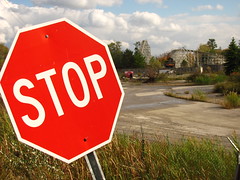 With monopolistic power over the Michigan/Ohio market, Michigan’s Adventure has stagnated in capital growth despite steadily increasing annual attendance (they were all but confirmed for a second major wooden coaster following Shivering Timbers under family ownership); King’s Island has turned into Cedar Point South with the rebranding of Soak City and Son of Beast is now entering its fourth season as a permanent lawn ornament; Cedar Point has traded in coasters (longest dry spell since following 1979 and Wildcat is getting the boot with no immediate replacement) for upcharge dinosaur dioramas; and Geauga Lake… well, that’s why you’re reading this, right?
With monopolistic power over the Michigan/Ohio market, Michigan’s Adventure has stagnated in capital growth despite steadily increasing annual attendance (they were all but confirmed for a second major wooden coaster following Shivering Timbers under family ownership); King’s Island has turned into Cedar Point South with the rebranding of Soak City and Son of Beast is now entering its fourth season as a permanent lawn ornament; Cedar Point has traded in coasters (longest dry spell since following 1979 and Wildcat is getting the boot with no immediate replacement) for upcharge dinosaur dioramas; and Geauga Lake… well, that’s why you’re reading this, right?
They cited the fact that the amusement park was unprofitable as the main justification for closing it, but they only tried to make it so for four years (I’m not counting 2004 because they didn’t buy it until March, which sort of guaranteed that year would be a loss because there was no time to organize any form of strategy, and most efforts had to be expended just on removing every trademarked reference in the park). In fact, I’d say they only really tried to make it successful for one year: 2005. That year they opened a reasonably expensive new waterpark on the site of the old SeaWorld property, a move that, even if it reduced the overall size and offerings of the park, I can’t fault them for since I think their policy to not keep exotic animals in their parks, especially for use in shows, is a wise one, and the old waterpark was awkwardly integrated and needed updating anyway.
as the main justification for closing it, but they only tried to make it so for four years (I’m not counting 2004 because they didn’t buy it until March, which sort of guaranteed that year would be a loss because there was no time to organize any form of strategy, and most efforts had to be expended just on removing every trademarked reference in the park). In fact, I’d say they only really tried to make it successful for one year: 2005. That year they opened a reasonably expensive new waterpark on the site of the old SeaWorld property, a move that, even if it reduced the overall size and offerings of the park, I can’t fault them for since I think their policy to not keep exotic animals in their parks, especially for use in shows, is a wise one, and the old waterpark was awkwardly integrated and needed updating anyway.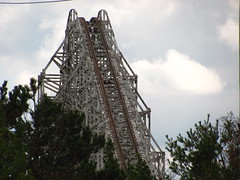
However, the following year (incidentally the same year Cedar Fair spent $1.25 billion to acquire the Paramount Park chain) they drastically cut back on the already announced phase two of Wildwater Kingdom and starting decommissioning several rides, such as the Sky Scraper and Bellaire Express, and Steel Venom broke down halfway through the season and never reopened. 2007 was such a bust year devoid of any attempt to attract new or repeat guests to the park that nearly everyone was predicting the park as a whole would be gone by 2008, with the only evidence to the contrary being the management’s continued insistence that nothing bad was happening to the park. And I was one of those people stupid enough to believe them. I couldn’t believe any rational enterprise would completely give up after four years of not really trying to turn things around. Cedar Fair just got greedy when the Paramount deal landed on their laps, and after biting off more than they could chew there had to be some park in the chain that would become the sacrificial lamb to the debt gods. It’s just a shame they had to be so deceitful and backhanded to fans and the community just before they decided to shut down the park for good.
any rational enterprise would completely give up after four years of not really trying to turn things around. Cedar Fair just got greedy when the Paramount deal landed on their laps, and after biting off more than they could chew there had to be some park in the chain that would become the sacrificial lamb to the debt gods. It’s just a shame they had to be so deceitful and backhanded to fans and the community just before they decided to shut down the park for good.
Cedar Fair’s interest first and foremost is to make a profit and appease their stockholders (of which I have been one for nearly a decade now, albeit not in any significant quantity), and the situation surrounding the closure of Geauga Lake confirmed that. ACE was very close to striking a deal which could have allowed the Big Dipper to remain on site and continue to be part of the Cleveland community for the indefinite future, but Cedar Fair was impatient and wanted to quickly liquidate as many assets as possible. A line of black ink on the balance sheet reading $5,000 (remember this is a company that has billions of dollars of revenue each year) was all that they needed to justify selling it to an unknown party whom there was good reason to believe would ensure that it would never run again.
the Big Dipper to remain on site and continue to be part of the Cleveland community for the indefinite future, but Cedar Fair was impatient and wanted to quickly liquidate as many assets as possible. A line of black ink on the balance sheet reading $5,000 (remember this is a company that has billions of dollars of revenue each year) was all that they needed to justify selling it to an unknown party whom there was good reason to believe would ensure that it would never run again.
And do you know who I blame most for the demise of the Big Dipper? Not Cedar Fair or Apex. I blame the roller coaster enthusiast community.
On the Genealogy of Online Coaster Enthusiast Morals
The only reason there could be any imperative to save the Big Dipper is if there are people in the world for whom saving the Big Dipper would have been important to. After the second deal with ACE fell through, an increasingly unlikely series of attempts to rescue the coaster took place, and it ended up revealing a very ugly side of the coaster community that more than ever made me question if I was comfortable calling myself an “enthusiast”. At first it seemed as if no one wanted to rescue the historic roller coaster. Sure, there may have been some sentiments that it would be nice to see it preserved, but an extreme few were willing to do anything about it. Two enthusiasts actually were willing to do something about it: a college student from Ohio and a man from New Zealand. They got in contact with Apex, who apparently realized that once ACE left the table they were left with a big pile of wood and so was willing to accept any offer from anyone still interested in buying the coaster off of them. Needless to say, the duo’s plans for the coaster weren’t exactly as complex as a Swiss Army Knife, and even if they could raise the amount of money they were asking for through donations, skepticism over their ability to successfully transport and relocate the coaster was justifiable, to say the least. However, the response within certain large online enthusiast sites quickly devolved from reasoned skepticism into a collective attempt to ridicule, belittle, and even intentionally sabotage the (extremely) grassroots preservation effort.
The problem wasn’t that these two were trying to save the Big Dipper; it was that these two were the only people left trying to save the Big Dipper. An argument could probably be made that ACE in the 21st century is out of touch with younger enthusiasts in the digital age, and the organization serves little function besides holding the occasional prosaic events and a dedication to the expansion of waist lines. But back in the 80’s and 90’s when they constituted a pretty sizeable bloc of enthusiasts, ACE was able to organize enthusiast led and funded relocation and/or restoration projects that got results. The top ten ranked Phoenix at Knoebel’s, the beautiful Giant Dipper in San Diego, the 1901-built Leap The Dips at Lakemont Park, and others, would probably not be thrilling riders to this day if coaster enthusiasts never felt empowered in their ability to make a difference in the fate of these rides.
Since most enthusiast groups have migrated almost exclusively into the internet, there has been an increase in attitudes of passivity and fatalism. This is easily measurable in the decline of significant enthusiast-led preservation efforts of historic roller coasters over the past decade, but it becomes readily apparent just through reading message board discussions. Something that I will call “Online Enthusiast Morality” has developed as a means of regulating enthusiast’s behavior and disenabling them from active participation beyond role of the passive spectator and obedient consumer.
The reason that a morality would develop that subjugates the fans to this role is tied to the proliferation of the internet as the dominant medium through which enthusiast participation takes place. The decentralizing effect of the internet has limited the bargaining ability over parks of a lone virtual community, unlike when this power had been aggregated into a single, physical card-carrying collective. With reduced numbers and minimal resources, to be granted special treatment from the parks (enthusiast events, interviews, etc.) the online enthusiast community needed to sell themselves to the park as an extension of their Public Relations tools. This generally required the enforcement of norms in the community that ensure the interests of the enthusiasts are always aligned with the interests of the business. Although a certain degree of free speech is allowable at the individual level where it is harmless to the business organization, the community as a whole must never pursue interests that threaten to destabilize their relationship to the park as a promotional tool.
To achieve this, a subtle form of fatalism is promoted as a virtue for Online Enthusiast Morality. The individual can do nothing to affect their favorite park’s policies or the design of the most recent attraction, and so to criticize parks along these lines is not just a waste of productivity (by the time you sit down to talk about coasters online you’ve already said to hell with productivity), it risks various forms of reprimand, even potentially getting banned from all future discourses. There’s an often unstated (and sometimes stated) commandment that a good enthusiast understands and empathizes with the fact that theme parks are a business, and (so the argument goes) businesses are in business only to sustain their own profits. Not only does this justify any decision made by the business as long as it helps their own income, but the interests of the good enthusiasts must align with the interests of the business. (This usually ignores countless counterexamples of businesses and individuals being motivated to act by other sources than immediate monetary gain.) Enthusiasts that openly reject this fatalistic norm, such as the two who tried to independently save the Big Dipper, quickly become labeled as “bad enthusiasts”.
Attempts to criticize parks on the grounds of what should be done (for example, Geauga Lake should have refused to put the Big Dipper up for auction and donated it to ACE to help find a way to preserve it, or they should not have closed the amusement park at all) are usually dismissed for failing to understand the business interests at stake in an amusement park operation. A “bad” enthusiast might say “The case is that X, but it should be that Y”, to which the “good” counterargument is often “But the case is that X, and a full understanding of the situation would probably reveal that there are no alternatives, so statements of ‘should’ are meaningless”. While a causally deterministic model of reality would support such an argument, it serves absolutely no purpose on the human level other than to enforce a norm of (usually condescending) fatalism. Many people argued the fact that Cedar Fair is a business and the Big Dipper was no longer part of their interests once they decided to close the park, while making no distinction between the factuality of the situation and any sort of ethical imperative. Some people not only demonstrate pride in their ability to show no emotional affliction at the needless demolition of a beloved ride by private interests, but seem pleased when these outcomes actually do happen, because it reinforces the perceived accuracy of their ‘realistic’ worldview. The underlying belief in this behavior seems to be that realism is mutually exclusive to idealism. This fails to make the distinction between discussions on the world as it is versus how it ought to be, while both are extremely valuable discourses that should run independently of each other.
Notice, in Online Enthusiast Morality, “criticism” is always reducible to “complaining”. It can’t even be reduced to “a complaint”, because that indicates a one-time observation spurred by a specific incident, while “complaining” is a perpetual state or attitude of the individual that can be dismissed as the trait of a bad enthusiast. The choice of language is an extremely important tool for perpetuating a particular normative standard within a community. To criticize a park within the confines of Online Enthusiast Morality, one must first take caution to signify their statements as “my honest opinion”. This is basically a way to avoid responsibility for the criticism, since a totally subjective opinion is essentially arbitrary and doesn’t impact the opinion of anyone else, unless by coincidence they already happen to share the opinion. This ‘moral’ behavior of stating harmless, subjectively-grounded “opinions” rather than harmful, objectively-grounded “criticisms” (unless the criticism is obvious and already community endorsed) is promoted under the guise of keeping civility and order in the discussion, but it really is only a means of minimizing any potential threat to the established community norms or the financial interests of the amusement park in question.
Then there is a belief perpetuated among members that the enthusiast community is of little to no value to the amusement parks. They create an entity called the “general public”, which is basically an anonymous out-group consisting of anyone who is not part of the broader enthusiast community that visits amusement parks. The “general public” is usually characterized condescendingly, as ignorant, impulsive, and of poor tastes relative to the enthusiast. Yet at the same time, the GP are of infinite more importance to the amusement park than the enthusiasts, because parks are only profit-motivated and the general public is how they make the vast majority of their profits. (As if entertainment businesses make decisions only by running focus groups with customers of the lowest common denominator, and place absolutely no higher value in the critical consensus of people with experience or good taste.) This apparent contradiction between the inherent superiority yet fundamental inefficacy of being an enthusiast is a means of encouraging people to remain involved in the community while simultaneously limiting their belief that anything they say within the community will have any material importance outside the online walled gardens. People only participate as enthusiasts for their own instantaneous gratification, and critical thinking can therefore only be harmful to this objective. Therefore, enthusiast morality states that theme parks should not be grateful for having fans. Rather, fans should be grateful for having theme parks. Unlike the general public, who only owe theme parks their money, fans owe them their money and their continued, uncritical loyalty.
As a result of this lack of critical scrutiny, the amusement industry has been afforded the luxury of being one of the most secretive and closed door entertainment industries relative to their fanbase. There are virtually no media institutions in the amusement industry that are not extended promotional tools to advance their immediate business interests, as there are with professional film or music criticism. Interviews rarely talk at any depth about craft or theory as a filmmaker or musician would (“industry secrets”), but are essentially viewed as PR tools useful for selling more tickets to a particular category of customers. The industry is in such a creative rut that it’s hard to even think about ways in which attractions could be better (conceptually, thematically) that’s different from the established order.
This lack of information flow or critical/theoretical framework has meant that “critical” enthusiasts become easy targets for derision from “moral” enthusiasts. Discussion among fans tends to be very misinformed due to the almost complete absence of any useful literature or news sources, either from within the industry or from professional criticism. This makes it much easier to keep the population subjugated under Online Enthusiast Morality because any attempts to criticize are always dismissed as being made in ignorance. But there’s virtually no way for one to become informed without becoming involved in the industry first-hand, at which point their interests will once again be aligned with the perpetuation of these norms. Accordingly, critical enthusiasts have almost nothing to talk about except exceedingly insignificant details; i.e. “I don’t like that paint selection, the paneling looks weird”. While this sort of discussion is usually (rightly) yelled at for being unacceptably negative in tone relative to the triviality of concerns, the exact same discussion in a positive fashion (I love this new paint, the paneling on this building looks spectacular!) is often commended.
This wall secrecy and a complacent, fatalistic attitude among fans has allowed companies like Cedar Fair to do things like unexpectedly close a 120 year old amusement park without any sort of resistance from the relevant communities (locals, fans, activists, etc), and they take absolutely no responsibility these actions because of it. The enthusiast community has enabled this sort of behavior both indirectly (a more actively involved community might have had enough leverage with the companies to have discovered the plans for closure before it was too late, and could have at least alerted people to make final visits and/or picket Cedar Fair) and directly (enforcing moral norms that try to limit the role of the enthusiast as that of the complacent consumer). Until the ability to have a free, rigorous, and informed critical discourse about these attractions is achieved on the same level that it has been for other entertainment sectors, this sort of irresponsible behavior towards our valued historic attractions will continue to perpetuate and be deemed acceptable.
that it has been for other entertainment sectors, this sort of irresponsible behavior towards our valued historic attractions will continue to perpetuate and be deemed acceptable.
I reconvened with my dad along Geauga Lake Road after taking my fill of pictures from the parking lot and the front gate. We drove around the back of the perimeter towards the remaining Raging Wolf Bobs structure. As we parked along the road, he suggested I climb up onto the roof of the car to get a better angle over the fence. I shimmied up, careful not to dent the hood, and took a couple photos of the decaying wooden structure and piles of track bed laid in a nearby clearing. I got back down, and we turned up the heating and drove on. We completed our tour around the lake, getting a few brief glimpses of the water park and the Big Dipper from across the water, and then turned east for our planned evening in Pittsburgh, Pennsylvania. I doubt I’ll ever see the Big Dipper or Geauga Lake again.
around the lake, getting a few brief glimpses of the water park and the Big Dipper from across the water, and then turned east for our planned evening in Pittsburgh, Pennsylvania. I doubt I’ll ever see the Big Dipper or Geauga Lake again.
The Big Dipper is dead.
Geauga Lake is dead.
Geauga Lake remains dead.
And we have killed it.
_
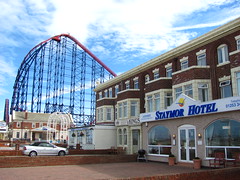
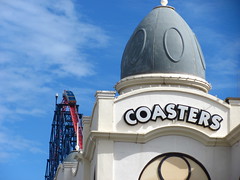
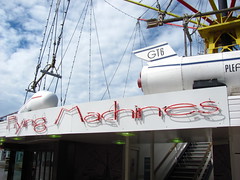
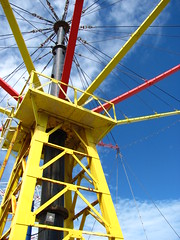
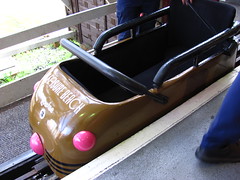



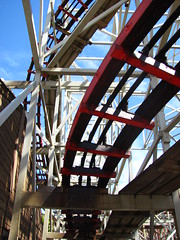
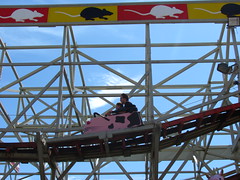

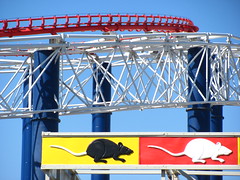
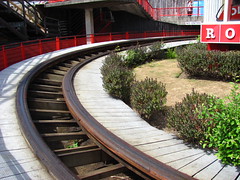
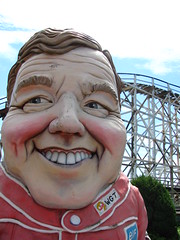
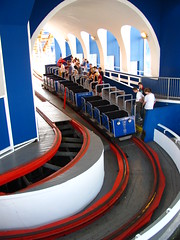
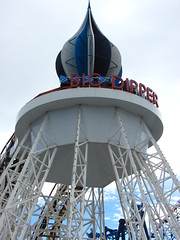
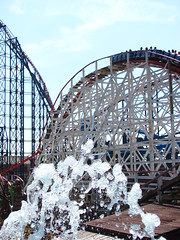

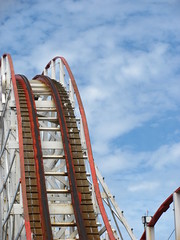

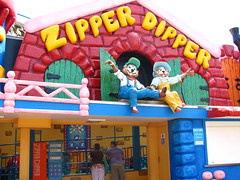
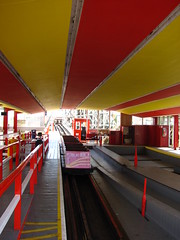
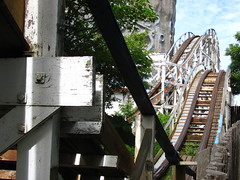
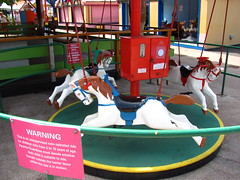
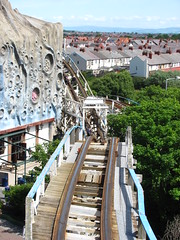
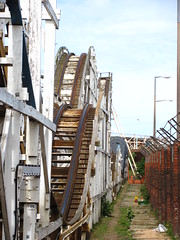
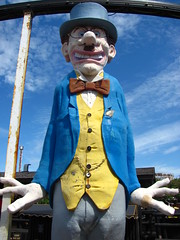
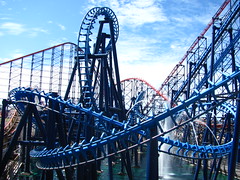
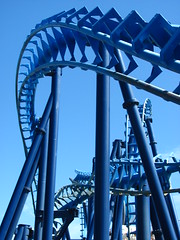
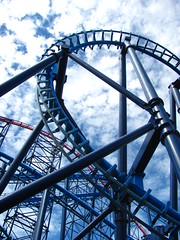
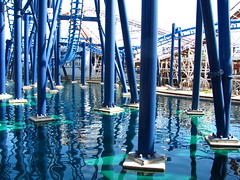

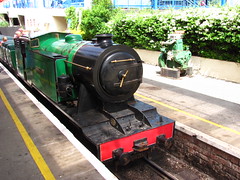

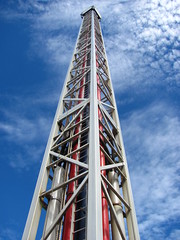
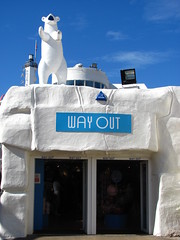
Comments